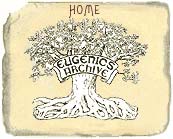
Eugenics Research Methods
David Micklos, Cold Spring Harbor Laboratory
Although eugenics became a popular movement in the United States, at its core was a research effort to apply Mendel's laws to the inheritance of human traits. Eugenics researchers attempted to trace the inheritance of a trait through a family tree, or pedigree. They sought to recognize basic patterns of inheritance that Mendel had presented in his original 1865 paper on peas. Beginning in 1900, Mendelian inheritance was extended to other plants, to animals, and to humans.
Mendel stated that each visible trait is governed by a pair of "factors" (later called genes). One member of each gene pair is inherited from the mother and one from the father. Genes may be dominant or recessive. A recessive trait is seen ("expressed") only when two recessive genes are inherited – one copy from each parent. A dominant trait is expressed when a dominant gene is inherited from one parent and a recessive gene from the other, or when a dominant genes are inherited from both parents. A sex-linked trait is expressed when males inherit a recessive gene on their single X chromosome.
By examining family pedigrees, eugenicists attempted to discern the pattern of one of these three basic modes of inheritance -- recessive, dominant, or sex-linked. Then, as today, the study of gene inheritance involves two important elements: 1) finding relatively large families that express the trait under study and 2) "scoring" each family member for the presence or absence of the trait. Eugenicists faired well on the first element, because large families were much more common in the first decades of the 20th century.
However, scoring traits was a difficult problem, especially when eugenicists attempted to measure complex traits (such as intelligence or musical ability) or complex mental illnesses (such as schizophrenia or manic depression). In general, eugenicists were lax in defining the criteria for measuring many of the "traits" they studied, and they were too quick to force their data to fit into simple Mendelian templates. It is important to remember that during the entire reign of eugenics, DNA had not yet been shown to be the molecule of heredity. Today, genetic researchers use DNA "markers" to follow trait inheritance. The presence or absence of the marker can be scored with great certainty. However, eugenicists had no physical road marks to help them follow inheritance through a family.
Several organizations in the United States were prominent in organizing and encouraging eugenics research: the Eugenics Record Office (ERO), the American Breeders Association (ABA), the Race Betterment Foundation, and the American Eugenics Society (AES). The ERO, established in 1910 at Cold Spring Harbor, New York, probably did the most to promote eugenics research. ERO founder Charles Davenport published several influential booklets that helped standardize nomenclature for pedigree studies. Budding eugenics researchers convened at Cold Spring Harbor each summer to learn how to conduct "field work" – interviewing subjects, taking medical histories, and constructing pedigrees.
Much eugenical information was submitted voluntarily on questionnaires–such as ERO's "Record of Family Traits" and "Family Tree Folder" – which coordinated family geneology with traits and medical conditions. Some families were proud to make known their pedigrees of intellectual/ artistic achievement, while others sought advice on the eugenical fitness of proposed marriages. One interesting subset of personal data were the "calling cards" of circus acts collected, and often annotated with pedigrees, by ERO workers. On the midways of Coney Island, eugenics researchers found circus performers who displayed a range of physical differences – from giantism, to dwarfism, polydactyly, and hypertrichosis. In one notable case, Charles Davenport's correspondence with an albino family, resulted inthe first Mendelian study of this condition, published in the Journal of Human Heredity.
Eugenicists also used data pooled from insane asylums, prisons, orphanages, and homes for the blind. Surveys filled out by superintendents were used to calculate the ethnic makeup of societal "dependents" and the costs of maintaining them in public institutions. With the mobilization for World War I, anthropomorphic and intelligence data became available for tens of thousands of men inducted for the draft. Robert Yerkes developed a test for the innate intelligence of army recruits. Foreign born recruits were much more likely to do poorly, probably because it was as much a test of American popular culture as of intelligence.
Harry Laughlin, director of the ERO, used these data sources in his testimony as "expert agent" for the Committee on Immigration and Naturalization of the U.S House of Representatives in the early 1920s. During three separate testimonies he presented data that purported to show that southern and eastern European countries were "exporting" genetic defectives to the United States who had disproportionately high rates of mental illness, crime and social dependency. A casual look at Laughlin's testimony will turn up examples of the ways he "skewed" some data and downplayed other data to fit his bigoted vision of America.
Eugenicists disseminated their research in journals and monographs, and presented seminars and posters at scientific meetings. The International Eugenics Congresses of 1921 and 1932 were the largest and most prestigious gatherings. However, many published works of eugenicists were short on data and long on anecdotal information. Eugenical News, published by the ERO from 1920-1938, was the dominant mouthpiece for the racist and anti-immigration agenda of eugenics research. By contrast, the more moderate journal Eugenics, published by the AES, lasted only three years (1928-31).
